Effects of Carbon Nanotube and Graphene Oxide Incorporation on the Improvements of Magneto-Induced Electrical Sensitivity of Magneto-Rheological Gel
Abstract
1. Introduction
2. Experimental Section
2.1. MRG Sample Prepration
2.2. Experimental Details
3. Results and Discussion
3.1. Microstructural Images of MRG Samples
3.2. Magneto-Induced Electrical Impedances of MRG Samples
3.3. Electrical Impedance Prediction Using Electrical Circuit Models
4. Conclusions
Author Contributions
Funding
Institutional Review Board Statement
Informed Consent Statement
Data Availability Statement
Conflicts of Interest
References
- Chang, Y.; Zhou, J.; Wang, K.; Xu, D. Theoretical and experimental investigations on semi-active quasi-zero-stiffness dynamic vibration absorber. Int. J. Mech. Sci. 2022, 214, 106892. [Google Scholar] [CrossRef]
- Feng, X.; Chen, H.; Wu, G.; Zhang, A.; Zhao, Z. A New Vibration Controller Design Method Using Reinforcement Learning and FIR Filters: A Numerical and Experimental Study. Appl. Sci. 2022, 12, 9869. [Google Scholar] [CrossRef]
- Leng, D.; Wu, T.; Liu, G.; Wang, X.; Sun, L. Tunable isolator based on magnetorheological elastomer in coupling shear–squeeze mixed mode. J. Intell. Mater. Syst. Struct. 2018, 29, 2236–2248. [Google Scholar] [CrossRef]
- Zhang, J.; Zhu, Y.; Tu, J.; Li, Z.; Wang, Q. Development and Vibration Control of Frequency Adjustable Tuned Mass Damper Based on Magnetorheological Elastomer. Materials 2022, 15, 1829. [Google Scholar] [CrossRef]
- Liu, G.; Lu, K.; Zou, D.; Xie, Z.; Rao, Z.; Ta, N. Development of a semi-active dynamic vibration absorber for longitudinal vibration of propulsion shaft system based on magnetorheological elastomer. Smart Mater. Struct. 2017, 26, 075009. [Google Scholar] [CrossRef]
- Ahmad Khairi, M.H.; Mazlan, S.A.; Ubaidillah; Choi, S.B.; Abdul Aziz, S.A.; Mohamad, N.; Hapipi, N.M.; Nordin, N. Role of Additives in Enhancing the Rheological Properties of Magnetorheological Solids: A Review. Adv. Eng. Mater. 2019, 21, 1800696. [Google Scholar] [CrossRef]
- Li, R.; Li, X.; Li, Y.; Yang, P.-a.; Liu, J. Experimental and numerical study on surface roughness of magnetorheological elastomer for controllable friction. Friction 2019, 8, 917–929. [Google Scholar] [CrossRef]
- Jang, D.I.; Yun, G.E.; Park, J.E.; Kim, Y.K. Designing an attachable and power-efficient all-in-one module of a tunable vibration absorber based on magnetorheological elastomer. Smart Mater. Struct. 2018, 27, 085009. [Google Scholar] [CrossRef]
- Bastola, A.K.; Li, L. A new type of vibration isolator based on magnetorheological elastomer. Mater. Des. 2018, 157, 431–436. [Google Scholar] [CrossRef]
- Lee, K.H.; Park, J.E.; Kim, Y.K. Design of a stiffness variable flexible coupling using magnetorheological elastomer for torsional vibration reduction. J. Intell. Mater. Syst. Struct. 2019, 30, 2212–2221. [Google Scholar] [CrossRef]
- Wang, Y.; Xuan, S.; Ge, L.; Wen, Q.; Gong, X. Conductive magnetorheological elastomer: Fatigue dependent impedance-mechanic coupling properties. Smart Mater. Struct. 2016, 26, 015004. [Google Scholar] [CrossRef]
- Zainudin, A.A.; Yunus, N.A.; Mazlan, S.A.; Shabdin, M.K.; Aziz Abdul, S.A.; Nordin, N.A.; Nazmi, N.; Rahman, M.A.A. Rheological and resistance properties of magnetorheological elastomer with cobalt for sensor application. Appl. Sci. 2020, 10, 1638. [Google Scholar] [CrossRef]
- Ge, L.; Gong, X.; Wang, Y.; Xuan, S. The conductive three dimensional topological structure enhanced magnetorheological elastomer towards a strain sensor. Compos. Sci. Technol. 2016, 135, 92–99. [Google Scholar] [CrossRef]
- Jang, D.; Yoon, H.N.; Seo, J.; Cho, H.J.; Kim, G.M.; Kim, Y.-K.; Yang, B. Improved electromagnetic interference shielding performances of carbon nanotube and carbonyl iron powder (CNT@CIP)-embedded polymeric composites. J. Mater. Res. Technol. 2022, 18, 1256–1266. [Google Scholar] [CrossRef]
- Yuan Liu; Yueming Li Vibration and Acoustic Response of Rectangular Sandwich Plate under Thermal Environment. Shock Vib. 2013, 20, 1011–1030. [CrossRef]
- Bhandari, M.; Wang, J.; Jang, D.; Nam, I.; Huang, B. A Comparative Study on the Electrical and Piezoresistive Sensing Characteristics of GFRP and CFRP Composites with Hybridized Incorporation of Carbon Nanotubes, Graphenes, Carbon Nanofibers, and Graphite Nanoplatelets. Sensors 2021, 21, 7291. [Google Scholar] [CrossRef]
- Qu, H.; Yu, M.; Fu, J.; Yang, P.; Liu, Y. Enhanced field-dependent conductivity of magnetorheological gels with low-doped carbon nanotubes. Smart Mater. Struct. 2017, 26, 105026. [Google Scholar] [CrossRef]
- Mollik, S.I.; Alam, R.B.; Islam, M.R. Significantly improved dielectric properties of bio-compatible starch/reduced graphene oxide nanocomposites. Synth. Met. 2021, 271, 116624. [Google Scholar] [CrossRef]
- Jyoti, J.; Kumar, A.; Dhakate, S.R.; Singh, B.P. Dielectric and impedance properties of three dimension graphene oxide-carbon nanotube acrylonitrile butadiene styrene hybrid composites. Polym. Test. 2018, 68, 456–466. [Google Scholar] [CrossRef]
- Bose, S.; Basu, S.; Das, A.; Rahman, M.; Drzal, L.T. Fabrication of a sulfonated aramid-graphene nanoplatelet composite paper and its performance as a supercapacitor electrode. J. Appl. Polym. Sci. 2017, 134, 45099. [Google Scholar] [CrossRef]
- Ma, W.; Li, M.; Zhou, X.; Li, J.; Dong, Y.; Zhu, M. Three-Dimensional Porous Carbon Nanotubes/Reduced Graphene Oxide Fiber from Rapid Phase Separation for a High-Rate All-Solid-State Supercapacitor. ACS Appl. Mater. Interfaces 2019, 11, 9283–9290. [Google Scholar] [CrossRef] [PubMed]
- Xu, J.; Xuan, S.; Pang, H.; Gong, X. The strengthening effect of 1D carbon materials on magnetorheological plastomers: Mechanical properties and conductivity. Smart Mater. Struct. 2017, 26, 035044. [Google Scholar] [CrossRef]
- Yu, M.; Ju, B.; Fu, J.; Liu, S.; Choi, S.B. Magnetoresistance characteristics of magnetorheological gel under a magnetic field. Ind. Eng. Chem. Res. 2014, 53, 4704–4710. [Google Scholar] [CrossRef]
- Khayam, S.U.; Usman, M.; Umer, M.A.; Rafique, A. Development and characterization of a novel hybrid magnetorheological elastomer incorporating micro and nano size iron fillers. Mater. Des. 2020, 192, 108748. [Google Scholar] [CrossRef]
- Khalid, H.R.; Jang, D.; Abbas, N.; Haider, M.S.; Bukhari, S.N.A.; Mirza, C.R.; Elboughdiri, N.; Ahmad, F. Electrical Stability and Piezoresistive Sensing Performance of High Strain-Range Ultra-Stretchable CNT-Embedded Sensors. Polymers 2022, 14, 1366. [Google Scholar] [CrossRef]
- Park, J.-E.; Yun, G.-E.; Jang, D.-I.; Kim, Y.-K. Analysis of Electrical Resistance and Impedance Change of Magnetorheological Gels with DC and AC Voltage for Magnetometer Application. Sensors 2019, 19, 2510. [Google Scholar] [CrossRef]
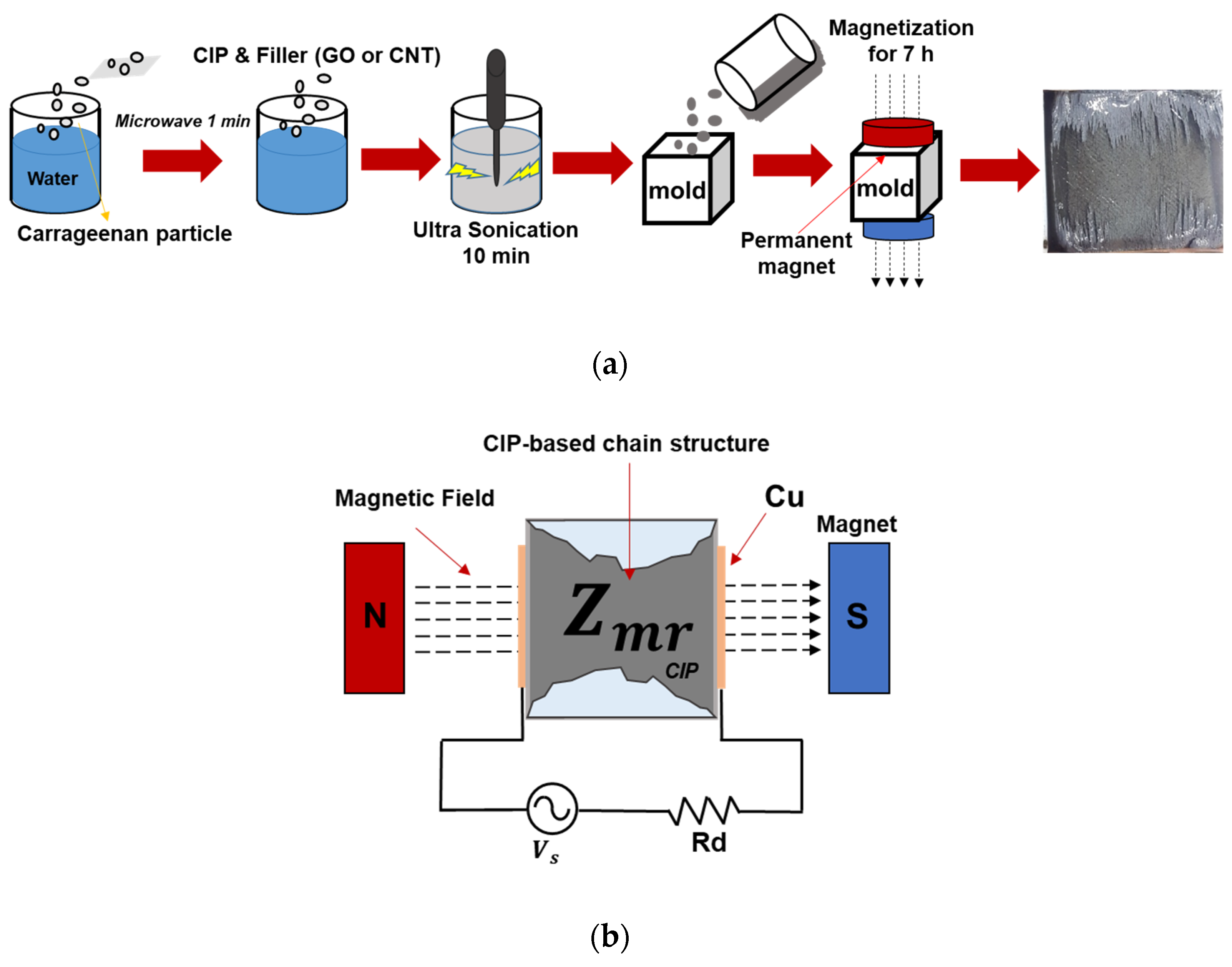
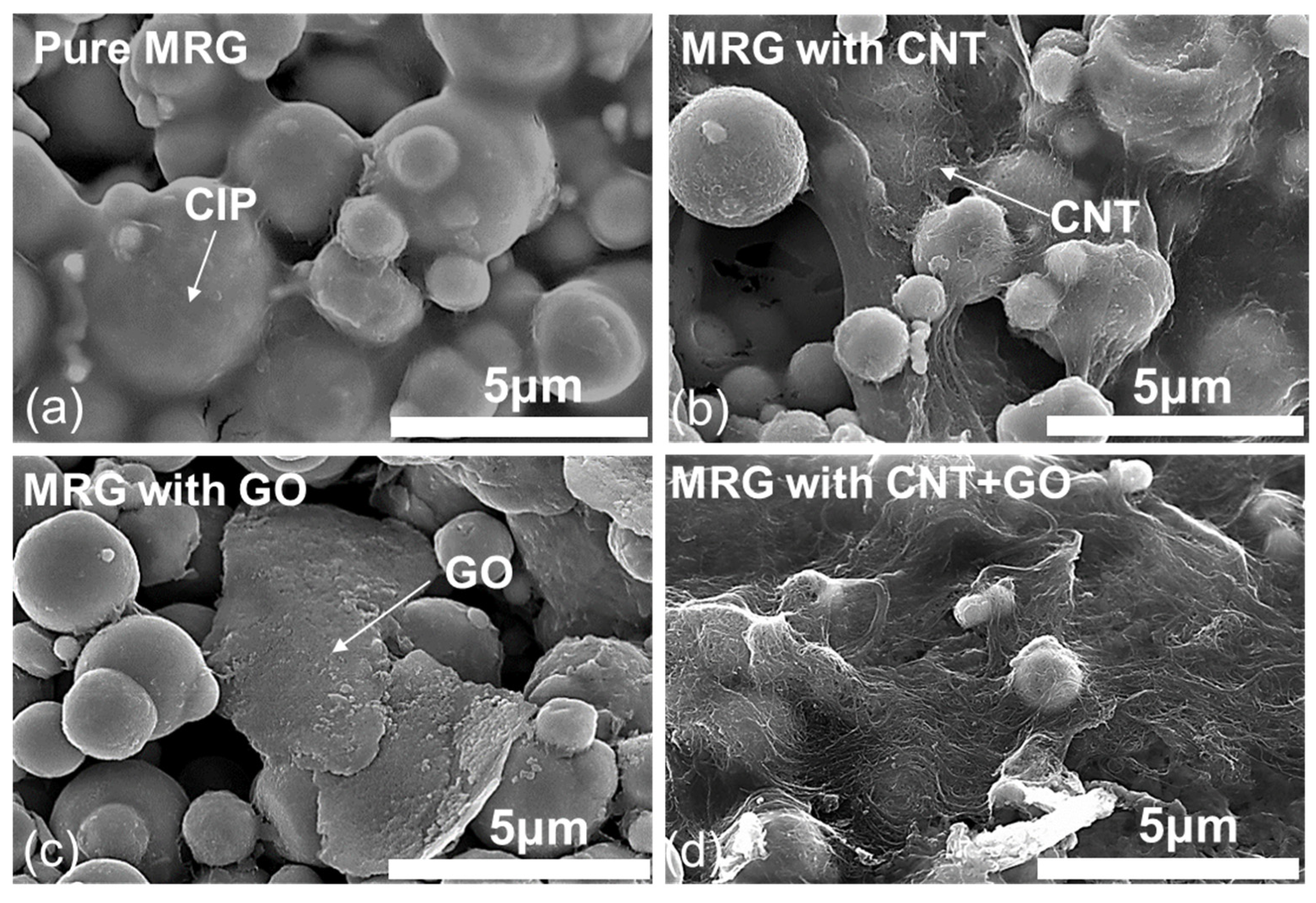
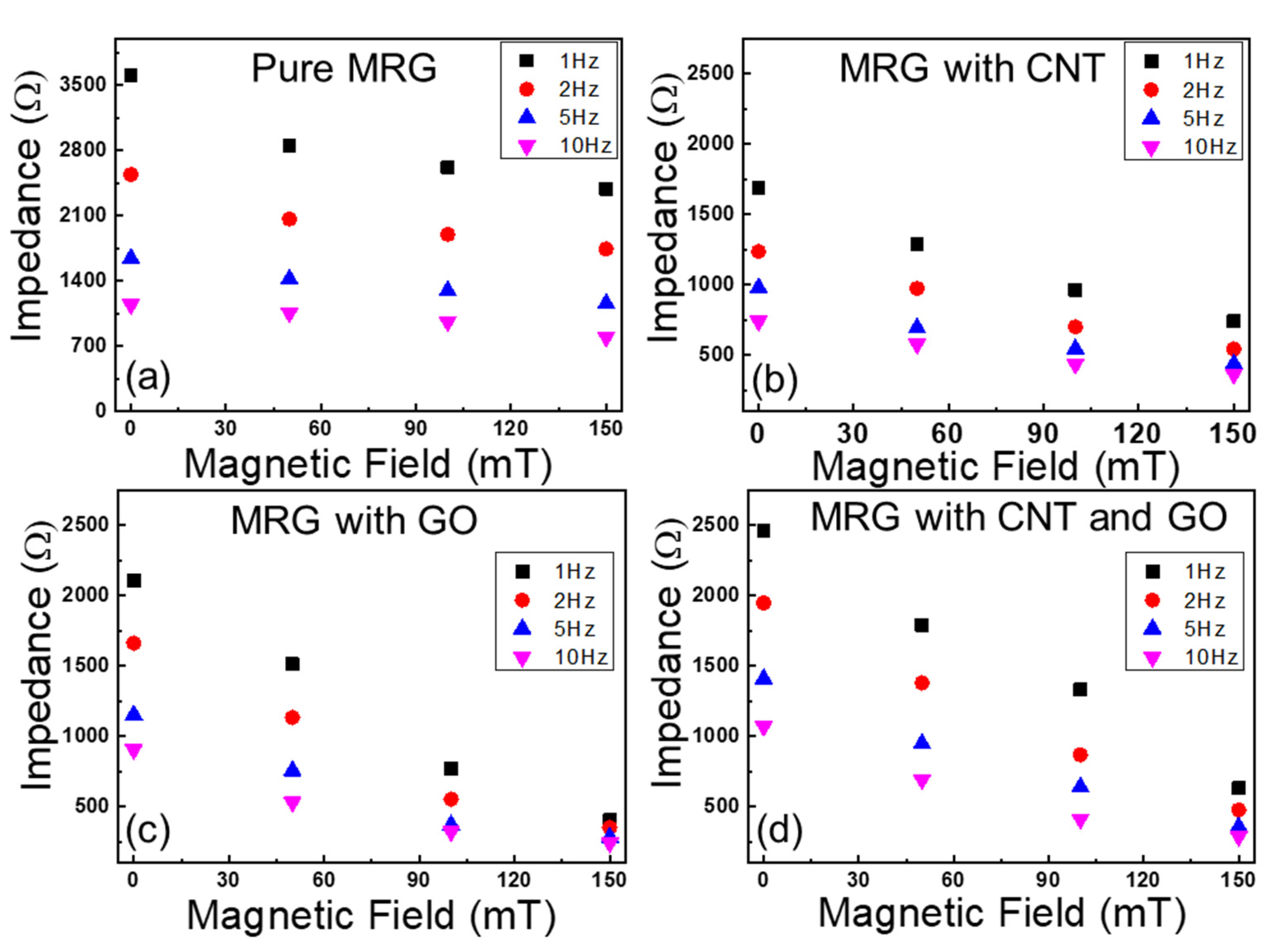
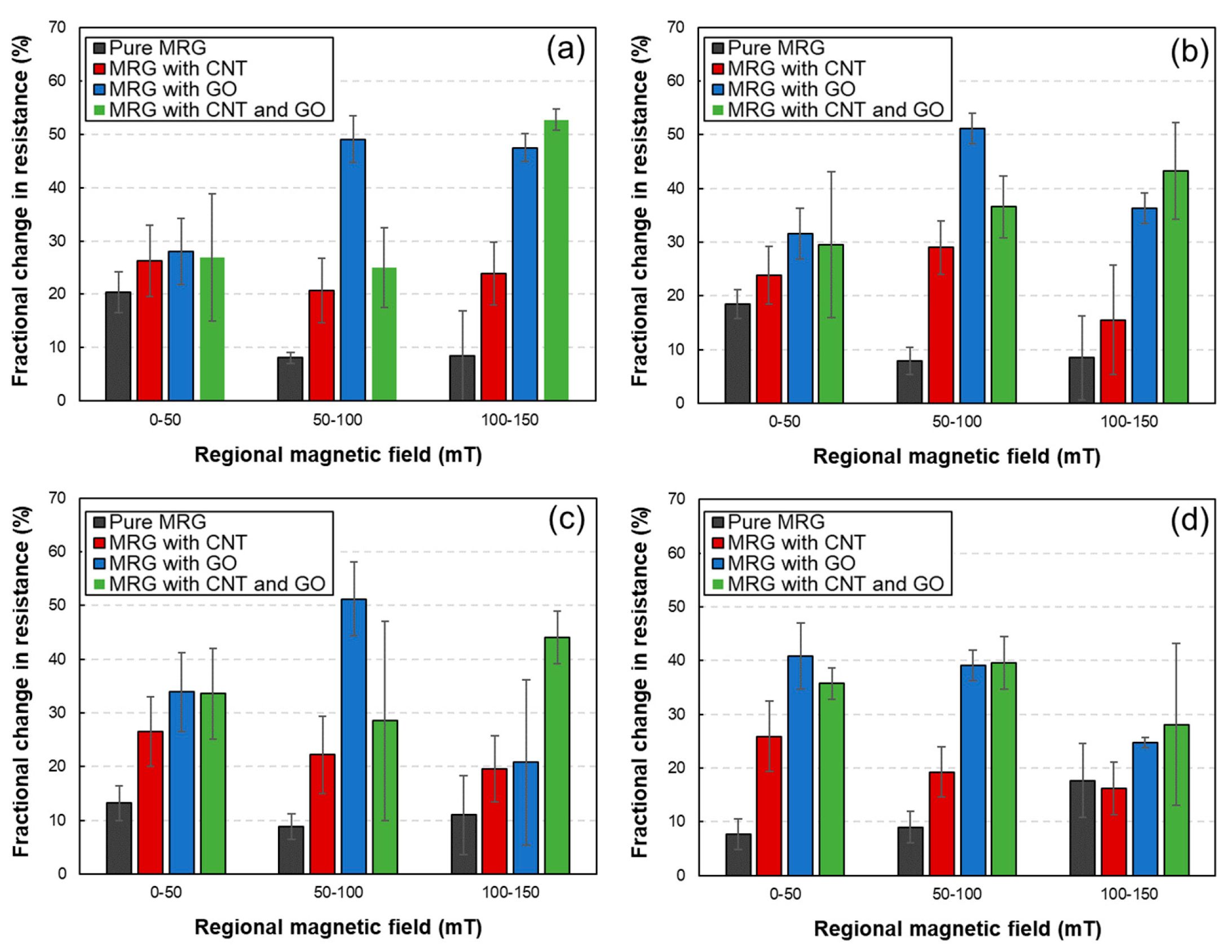
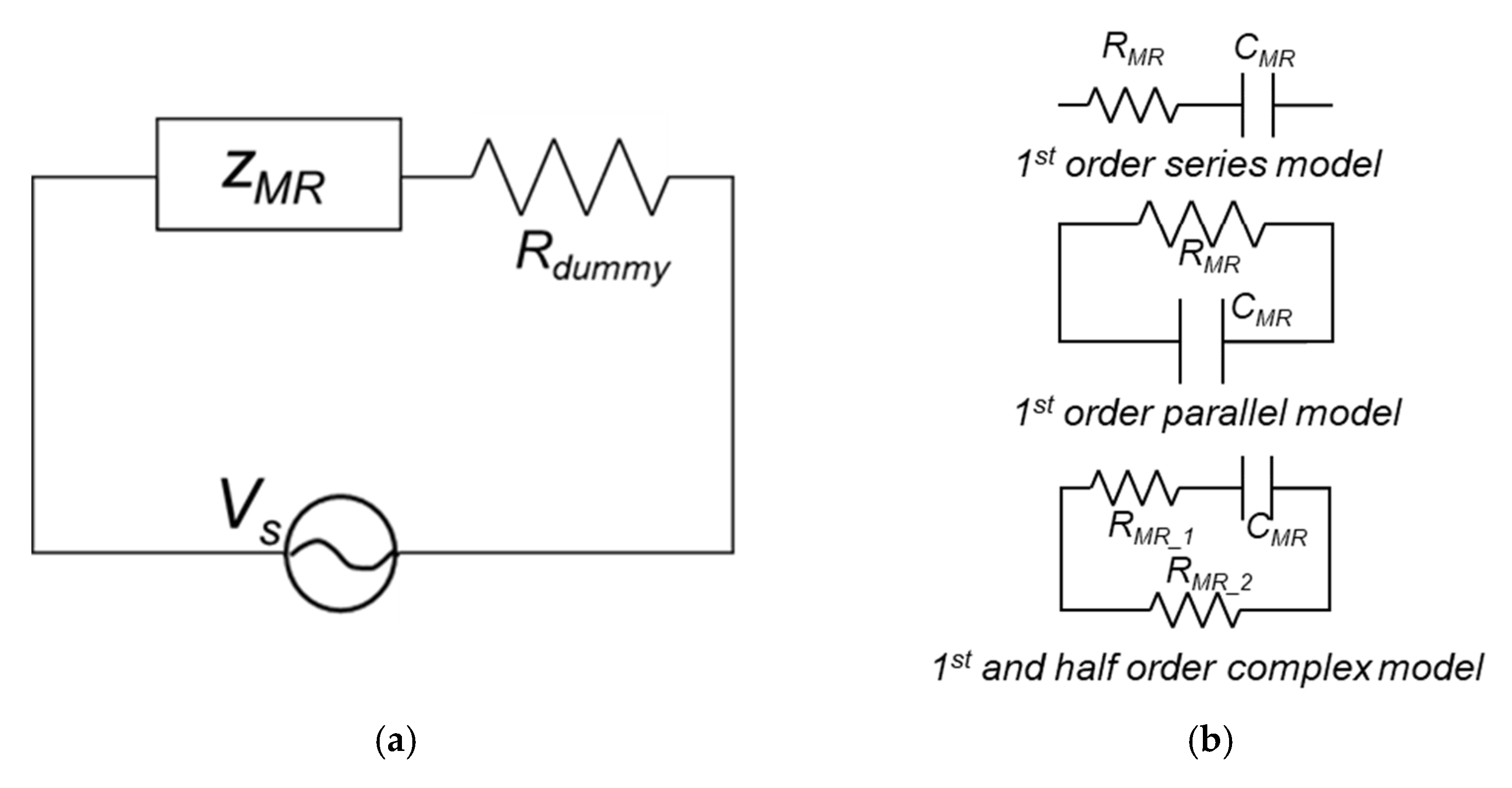
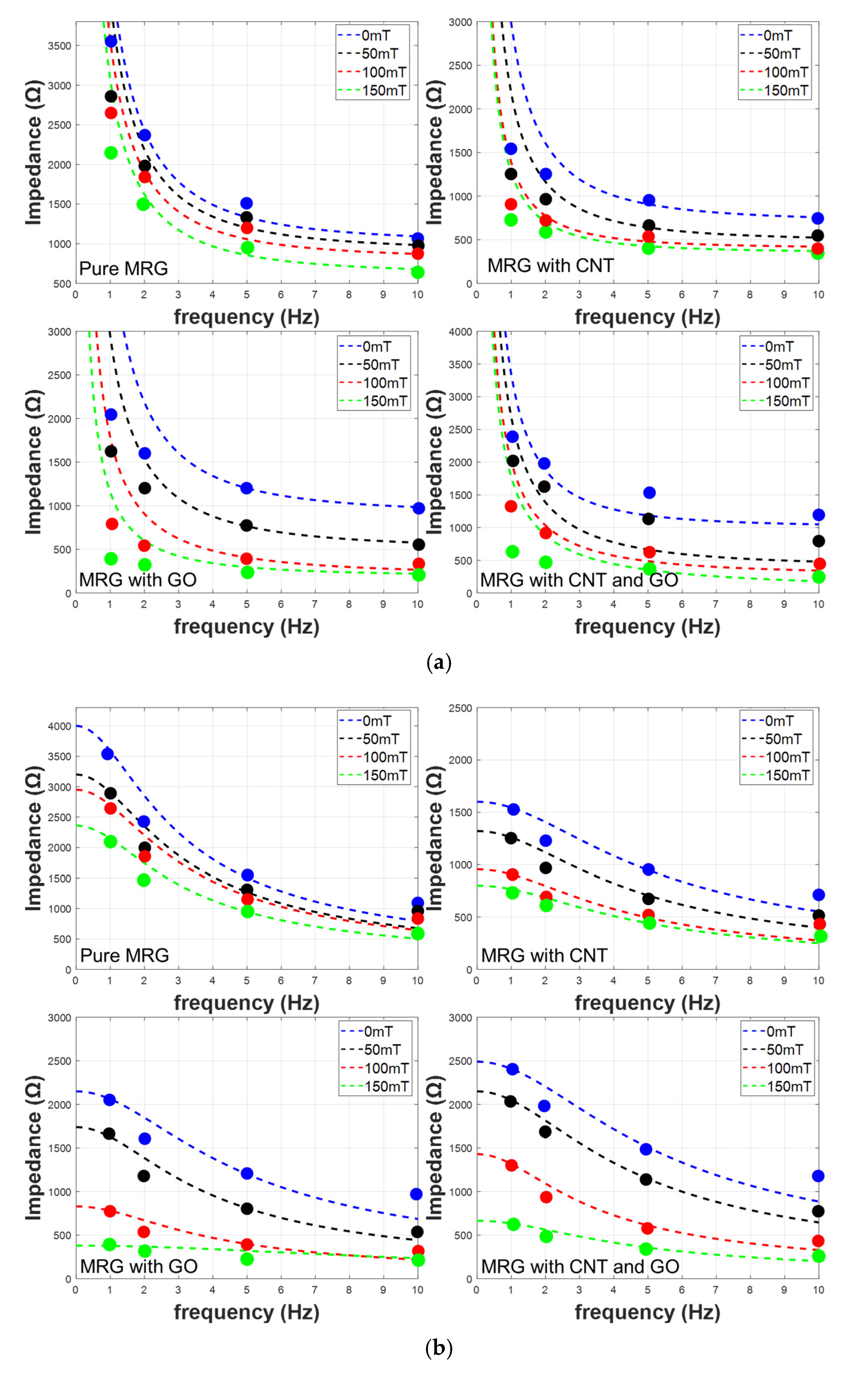

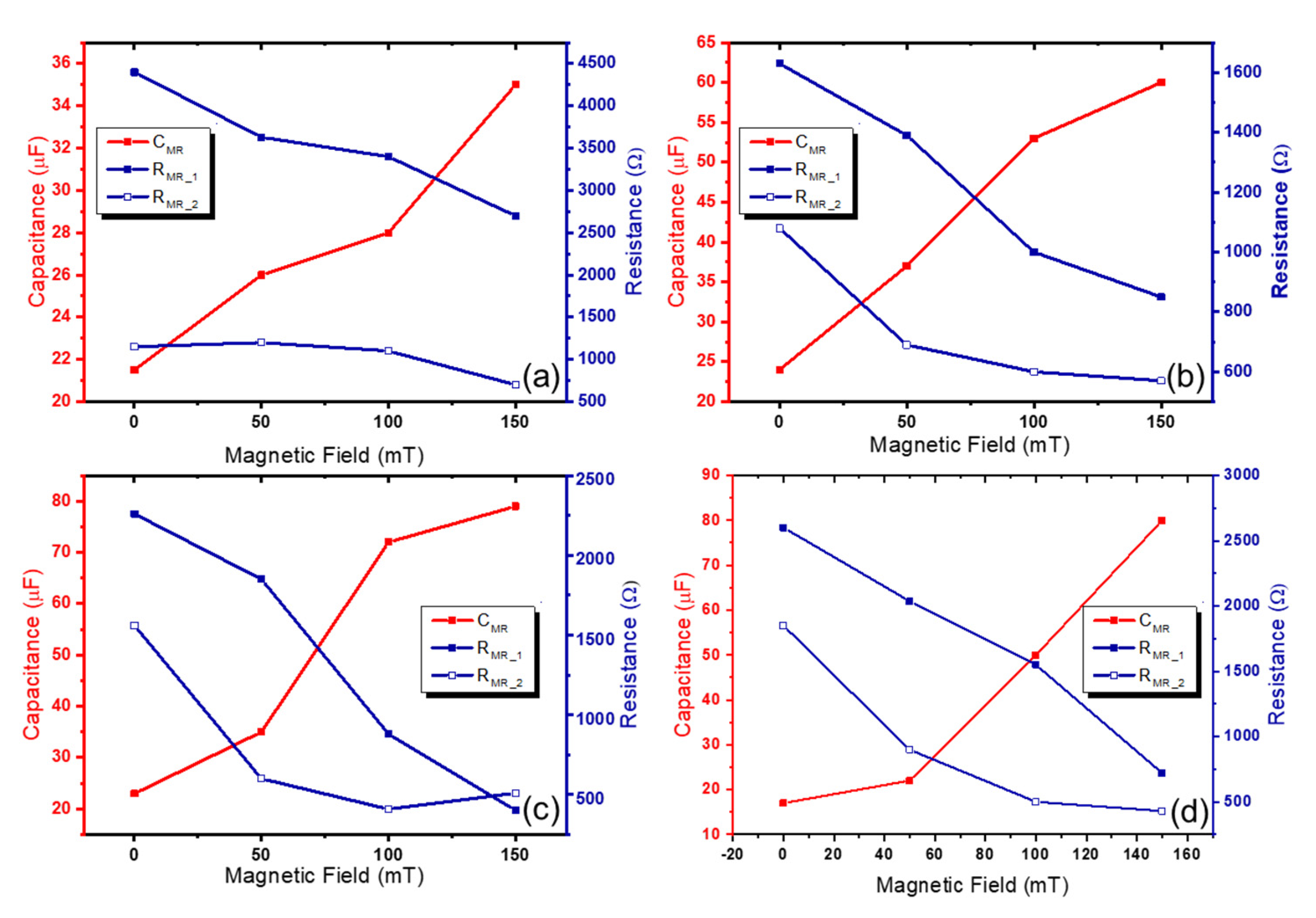
| Sample | Water | Carrageenan | CIP | CNT | GO |
|---|---|---|---|---|---|
| Pure MRG | 100 | 1 | 50 | 0 | 0 |
| MRG with CNT | 100 | 1 | 50 | 0.5 | 0 |
| MRG with GO | 100 | 1 | 50 | 0 | 0.5 |
| MRG with CNT and GO | 100 | 1 | 50 | 0.25 | 0.25 |
| Sample | (a) | |||
| 0 mT | 50 mT | 100 mT | 150 mT | |
| Pure MRG | 0.9676 | 0.9769 | 0.9673 | 0.9571 |
| MRG with CNT | 0.9096 | 0.9409 | 0.9447 | 0.9289 |
| MRG with GO | 0.9447 | 0.9535 | 0.9897 | 0.9395 |
| MRG with CNT and GO | 0.8966 | 0.9054 | 0.9758 | 0.9818 |
| Sample | (b) | |||
| 0 mT | 50 mT | 100 mT | 150 mT | |
| Pure MRG | 0.9619 | 0.9405 | 0.9515 | 0.9664 |
| MRG with CNT | 0.9477 | 0.9400 | 0.9281 | 0.9349 |
| MRG with GO | 0.9275 | 0.9567 | 0.9004 | 0.8067 |
| MRG with CNT and GO | 0.9451 | 0.9768 | 0.9487 | 0.9131 |
| Sample | (c) | |||
| 0 mT | 50 mT | 100 mT | 150 mT | |
| Pure MRG | 0.9937 | 0.9914 | 0.9948 | 0.9938 |
| MRG with CNT | 0.9865 | 0.9869 | 0.9920 | 0.9983 |
| MRG with GO | 0.9883 | 0.9896 | 0.9748 | 0.9949 |
| MRG with CNT and GO | 0.9882 | 0.9949 | 0.9916 | 0.9941 |
| Sample | Increasing of Capacitance | Decreasing of Resistance |
|---|---|---|
| Pure MRG | 63% | 39% |
| MRG with CNT | 150% | 47% |
| MRG with GO | 240% | 82% |
| MRG with CNT and GO | 370% | 72% |
Publisher’s Note: MDPI stays neutral with regard to jurisdictional claims in published maps and institutional affiliations. |
© 2022 by the authors. Licensee MDPI, Basel, Switzerland. This article is an open access article distributed under the terms and conditions of the Creative Commons Attribution (CC BY) license (https://creativecommons.org/licenses/by/4.0/).
Share and Cite
Jang, D.; Kim, Y.-K.; Lim, T.; Cheng, H.; Jung, W. Effects of Carbon Nanotube and Graphene Oxide Incorporation on the Improvements of Magneto-Induced Electrical Sensitivity of Magneto-Rheological Gel. Polymers 2022, 14, 5286. https://doi.org/10.3390/polym14235286
Jang D, Kim Y-K, Lim T, Cheng H, Jung W. Effects of Carbon Nanotube and Graphene Oxide Incorporation on the Improvements of Magneto-Induced Electrical Sensitivity of Magneto-Rheological Gel. Polymers. 2022; 14(23):5286. https://doi.org/10.3390/polym14235286
Chicago/Turabian StyleJang, Daeik, Young-Keun Kim, Taeuk Lim, Hao Cheng, and Wonsuk Jung. 2022. "Effects of Carbon Nanotube and Graphene Oxide Incorporation on the Improvements of Magneto-Induced Electrical Sensitivity of Magneto-Rheological Gel" Polymers 14, no. 23: 5286. https://doi.org/10.3390/polym14235286
APA StyleJang, D., Kim, Y.-K., Lim, T., Cheng, H., & Jung, W. (2022). Effects of Carbon Nanotube and Graphene Oxide Incorporation on the Improvements of Magneto-Induced Electrical Sensitivity of Magneto-Rheological Gel. Polymers, 14(23), 5286. https://doi.org/10.3390/polym14235286






